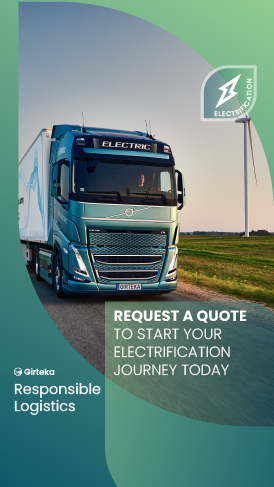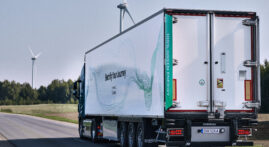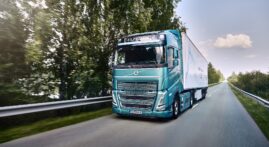Many components make up the road freight transport industry, ranging from small details such as mobile devices to ensure smooth communication between the multiple links of the supply chain, to large warehouses and perhaps most importantly, the trucks that enable the transfer of goods between point A and point B.
Over the course of history, as technology kept moving forward in the automotive sector, the perception of what a modern long-haul international truck should be equipped with has also shifted. The inclusion of the latest safety technologies became a must if a truck was to be truly modern, and as pressure has continued mounting for the industry to reduce its emissions, sustainability is becoming another must. While currently there are few alternatives available to the centuries-old combustion engine, the diesel engine has evolved, as the inclusion of alternative fuels is now available, in addition to other emissions-saving developments throughout the past few decades.
Nevertheless, there are a few strategies that a road freight transport company could employ in terms of its assets. A business can operate with very young trucks and trailers that are freshly acquired from the manufacturer and continuously refresh its fleet, choose to purchase second-hand trucks that are relatively new but acquired on the second-hand market, or look to operate trucks until the end of their useful life of a depreciable fixed asset.
All of the strategies, including their variations, have their benefits, as well as drawbacks.
The advantages of a young fleet
One of the key advantages that a very young fleet of trucks provides is access to the latest technologies, making the road freight transport process much safer and most importantly, more comfortable for the driver behind the wheel, as well as for road users around the truck.
For example, the Mercedes-Benz Actros, one of the models utilized by Girteka Logistics, has Active Brake Assist as standard, in addition to the other equipment seen on the logistics provider’s vehicles, such as the ground-breaking MirrorCam for additional visibility for drivers, further improving the safety of everyone on the road.
The Volvo FH with the I-Save system is able to provide fuel savings of up to 10%, compared to a regular Volvo D13 eSCR Euro 6 engine, by combining the manufacturer’s D13TC engine and the long-haul fuel package. Not only that does mean reduced fuel costs but it also means that less fuel is consumed to cover the same distance, resulting in fewer emissions. The newest Volvo FH, which is also present in Girteka Logistics’ fleet, also has numerous safety and comfort features, including lane keep assist and emergency braking systems to ensure the safety of the company’s drivers.
Such features, whether it would be from DAF, Mercedes-Benz, Volvo, or any other truck manufacturer, can be hardly accessed if operating an older fleet. At the same time, acquiring trucks directly is a Capital Expenditure-intensive process, especially since the current situation with carmakers across the globe is fairly dire due to the shortage of semiconductor chips.
It has to be noted that newer trucks have much lower operating costs, including maintenance, as well as being more reliable due to less wear and tear.
Replacing a truck that has already loaded and has departed towards its intended destination is not easy, in particular for small to medium enterprises with limited fleet availability. In turn, the company‘s image as a reliable logistics partner can potentially take a hit, which can be detrimental to a long-term partnership with a customer. In a situation where a truck breaks down in the middle of a delivery, a newly-acquired vehicle will still have its warranty, further reducing the potential expenses for a company, while second-hand trucks might not have the same or any kind of warranty cover at all.
Second-hand truck benefits
Despite their certain shortfalls, acquiring trucks from the secondary market can bring benefits for a logistics company. However, much like buying a passenger car, such acquisitions can carry a certain amount of risk.
There is no doubt that a used truck is much cheaper than a new one, as the initial acquisition cost was bore by the first owner. However, that trend, perhaps temporarily, has flipped. Due to the manufacturing shortfalls following semiconductor chip shortages, as well as local lockdowns at manufacturing facilities, truckmakers have struggled to keep up with the demand for new vehicles. In the US, as the Wall Street Journal reported in early September 2021, production levels of HGVs in the country dipped down to the levels last seen in May 2020, when much of the economy in the US was put on the back foot due to pandemic-related lockdowns. In Europe, the registrations of new trucks within the continent, including the United Kingdom, have dropped as much as 27% between 2019 and 2020, recovering by 18% in 2021, according to ING research.
As a result, with the demand picking up again, as ING expects the demand for new trucks to recover by 2022, and manufacturers lagging behind with production volumes, second-hand trucks’ values have shot up exponentially. While it might not be a situation that lasts long, as eventually, the chip crisis should be resolved with manufacturers once again being able to produce enough trucks to satisfy the demand, there are still risks associated with purchasing second-hand vehicles.
One of the key risks when buying an already used truck is its maintenance and usage history.
While there are companies, such as ClassTrucks that prepare the truck before selling them to their next owners, making sure that the assets were maintained correctly and timely, there are sellers that could be less reliable.
As mentioned previously, ensuring that your truck, and in broader terms your services, can be relied upon, is of the utmost importance for your customers.
Secondly, while to a lesser extent, is that older trucks are less safer than new equipment. While it is not a given that something will happen while a driver is on the road, it is much less likely to happen with a truck that is equipped with the latest safety technology. On the other side of the coin, there are situations, like the recently enacted changes to London, United Kingdom’s road rules, where commercial heavy-duty vehicles have to meet certain standards in order to enter the British capital’s road system. Called the Direct Vision Standard (DVS), the road regulators within London have informed operators that from March 1, 2021, zero-star rated trucks are no longer able to enter the city. Although DVS is a very local example, for now applying only to London, European Union (EU)-wide are also set to come in 2022.
Still, while DVS is a fringe case, for now, it is just one of the many examples of why partnering and operating a young fleet of trucks can provide less obvious benefits to both the shipper and the carrier. Despite their differences, there are arguments to be made for purchasing either new or older trucks. However, looking towards the long-term future, the difference in efficiency that fresh out of the factory HGVs showcase can be the tipping point that when deciding on how to expand or renew a fleet from an operator’s point of view.





